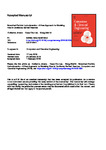Smoothed particle hydrodynamics – A new approach for modeling flow in oscillatory baffled reactors
| dc.contributor.author | Jimeno, G | |
| dc.contributor.author | Lee, Yeaw Chu | |
| dc.contributor.author | Ni, X-W | |
| dc.date.accessioned | 2021-05-07T09:26:24Z | |
| dc.date.available | 2021-05-07T09:26:24Z | |
| dc.date.issued | 2019-05-08 | |
| dc.identifier.issn | 0098-1354 | |
| dc.identifier.issn | 1873-4375 | |
| dc.identifier.uri | http://hdl.handle.net/10026.1/17099 | |
| dc.description.abstract |
Existing numerical models of mixing processes in oscillatory baffled reactors (OBR) are mainly Eulerian-based. An alternative Lagrangian based methodology, Smoothed-Particle Hydrodynamics (SPH), for predicting flow patterns and assessing mixing performance is presented in this paper. A bespoke SPH solver is developed for single phase modeling, as it is, for the first time, applied to OBR, and the results are compared with those from Eulerian modeling, i.e. Finite Volume (FV) method. SPH has successfully captured the expected flow characteristics in OBR as clearly and equally as its Eulerian counterpart, validating the SPH method. Since SPH provides historical information of individually tracked fluid packets/particles in the domain of interest, it allows for readily quantitative assessments of mixing without additional models. Two new indexes to assess mixing and plug flow efficiency have been proposed by making full use of SPH's capabilities. | |
| dc.format.extent | 14-27 | |
| dc.language | en | |
| dc.language.iso | en | |
| dc.publisher | Elsevier | |
| dc.subject | Smoothed Particle Hydrodynamics (SPH) | |
| dc.subject | Computational Fluid Dynamics (CFD) | |
| dc.subject | Lagrangian based modeling | |
| dc.subject | Oscillatory baffled reactor | |
| dc.subject | Flow patterns | |
| dc.subject | Mixing efficiency | |
| dc.title | Smoothed particle hydrodynamics – A new approach for modeling flow in oscillatory baffled reactors | |
| dc.type | journal-article | |
| dc.type | Journal Article | |
| plymouth.author-url | https://www.webofscience.com/api/gateway?GWVersion=2&SrcApp=PARTNER_APP&SrcAuth=LinksAMR&KeyUT=WOS:000461465600002&DestLinkType=FullRecord&DestApp=ALL_WOS&UsrCustomerID=11bb513d99f797142bcfeffcc58ea008 | |
| plymouth.volume | 124 | |
| plymouth.publication-status | Published | |
| plymouth.journal | Computers and Chemical Engineering | |
| dc.identifier.doi | 10.1016/j.compchemeng.2019.02.003 | |
| plymouth.organisational-group | /Plymouth | |
| plymouth.organisational-group | /Plymouth/Faculty of Science and Engineering | |
| plymouth.organisational-group | /Plymouth/Faculty of Science and Engineering/School of Engineering, Computing and Mathematics | |
| plymouth.organisational-group | /Plymouth/Users by role | |
| plymouth.organisational-group | /Plymouth/Users by role/Academics | |
| dcterms.dateAccepted | 2019-02-01 | |
| dc.rights.embargodate | 2021-5-26 | |
| dc.identifier.eissn | 1873-4375 | |
| dc.rights.embargoperiod | Not known | |
| rioxxterms.versionofrecord | 10.1016/j.compchemeng.2019.02.003 | |
| rioxxterms.licenseref.uri | http://www.rioxx.net/licenses/all-rights-reserved | |
| rioxxterms.licenseref.startdate | 2019-05-08 | |
| rioxxterms.type | Journal Article/Review |


